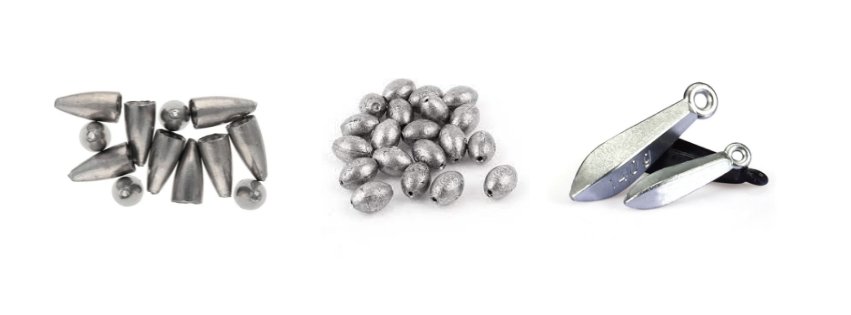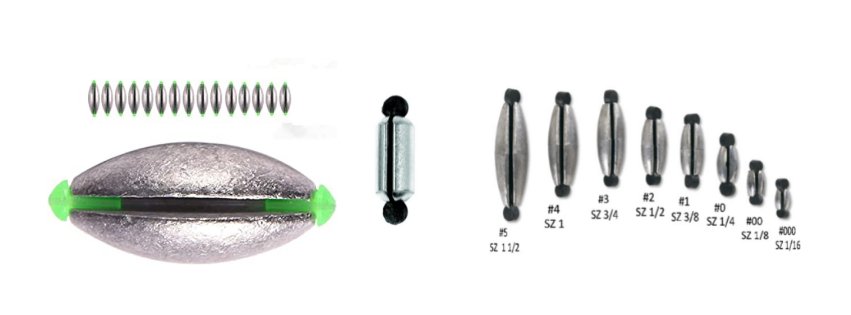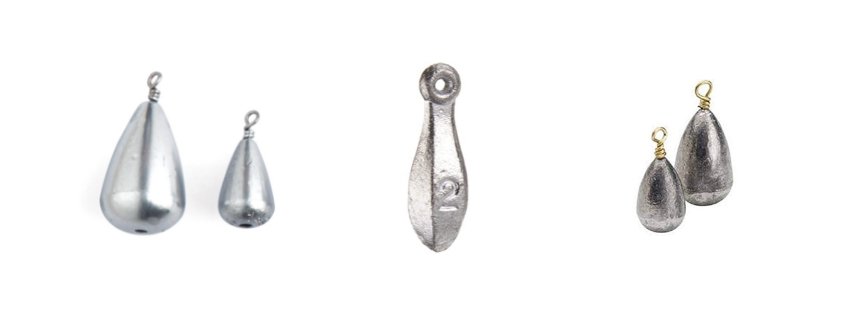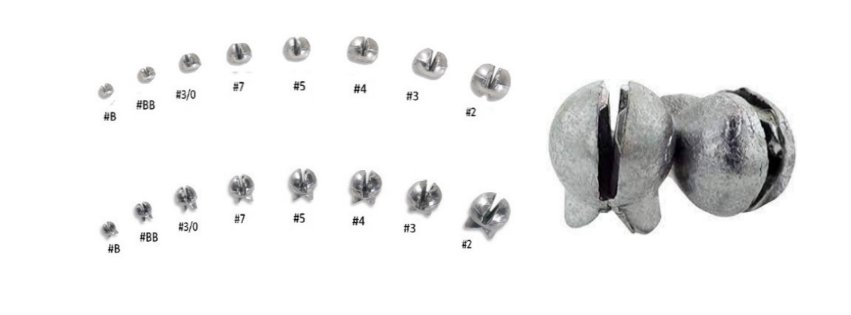Going to a lake or stream and having a fishing session can be fun. But going home without a fish isn’t. What most people especially beginner anglers or occasional ones don’t realize is that the bait is so away from the fishes.
Yes, the fishes lie below in the water while your bait is above the surface or just some inches below the water.

So what to do? To get it deep enough to lure the fishes. Well, it’s common sense to increase the weight of the line. But how can you do it?
The answer to this is fishing line weights. These weights help your bait reach a good depth in water and catch fish. Now if you are wondering what these weights are and how to attach them to your line then you are in the right spot.
Here is a brief guide explaining different kinds of fishing line weights and how you can put them on your line.
How to Attach Weights to the Fishing Line? (Step-By-Step Guide)
You can buy many types of fishing weights from the market, but putting them on the line will confuse you. Fishing line weights or sinkers need to attach properly and that too at the right place so that the bait can attract the fish without alerting them to the danger.
Types of Sinkers
- a Split-Shot
- an Egg Sinker
- a Bullet Sinker
- a Bell Sinker
- a Bank Sinker
- Hollow Core Lead Wire
Some of the most commonly used sinker types and a step-by-step guide to putting them on the line are as follows:
Rubber core sinkers or weights

Rubber core sinkers are cylinder-shaped metal pellets that have slit opening and rubber core inside. These are heavier weights that are mostly preferred when you want to increase the sensitivity of the line and sink the rig deeper. Rubber core sinkers should be placed at a good distance from the hook, at least at 1 ft. spacing.
- To attach rubber core sinker on the line:
- First, push the line through the narrow slit on the sinker
- Once the line is in the pellet, push it inside on the rubber core
- Then twist both sides of the rubber in the opposite direction like we unwrap a toffee
- If you want to change the sinker position you can simply unscrew it and place it as you like.
Because they are somewhat larger than split shot weights, they allow you to fish in deeper water. Because they are simple to connect to your line, you may put them on and take them off without having to untie any knots.
Ring loop or pear-shaped sinkers
Ring look or eye sinkers are great for windy and high current conditions. Theycan sink your rig deep and keep it there to lure fishes without moving much due to strong winds or water pressure.

These sinkers are pear-shaped and have a loop or ring on top. You can try bullet-shaped or egg-shaped sinkers too on your fishing line. To attach these weights to the line
- Remove your hook and other elements from the line
- Now slide your weight via putting the line in the ring or loop on the weight
- Once you have reached your desired position, tie a knot to secure the weight there
- Now attach your hook or any other weight you would like.
Split-shot sinkers
Split-shot weights or sinkers are one of the most common and lightest sinkers used with fishing lines. These are small metal balls with slit openings on one side. These sinkers are fit to use on warm waters or ponds where fishes are floating near the surface or where the wind and currents pressure is low.

Use 2 or 3 weights in combination to get our desired rig sensitivity. The split-shot weights are usually placed at 30-50 cm above the hook. To attach these weights to your fishing line:
- Use a nose plier to open the slit and then push your line inside the sinker
- Now using a plier press the sinker gently so that it gets looked around the line
- Now pull the sinker to check whether it is perfectly secured on the line and won’t move.
Split shot weights appear to be little metal balls with a huge split on one side. Split shot weights may not drag your bait as deep as other sinkers since they are lighter, but they are excellent for capturing any sort of fish in ponds, lakes, and rivers.

Placement of sinker:
The placement of sinkers on fishing line is determined by the intricacy of the rig and the planned bait presentation. Sinkers come in a variety of forms and sizes, each designed for a specific purpose in fishing. The kind of sinker determines how to attach it to fishing line.
Here are the most common fishing sinkers.
Tools needed to attached the fishing weight:
Fishing line weights are used to measure the strength of fishing lines. They’re also used to calculate the amount of force required to pull a fish out of water.
In order to attach a weight to a fishing line, you’ll need some basic tools and materials. Here’s a list of things you’ll need:
1. Fishing Line
You can buy fishing line at almost any sporting goods store. But, if you’d like to make your own, here’s a simple recipe:
Take 1/8th inch diameter nylon monofilament fishing line and cut it into 3 foot lengths.
Then, tie knots every 6 inches along the length of the line.
2. Scissors
Scissors are useful for cutting fishing line.
3. Wire Cutters
Wire cutters are handy for snipping wire apart.
4. Tape Measure
Tape measures are helpful for measuring the distance between knots.
5. Pencil
Pencils are useful for marking the location of knots.
6. Ruler
Rulers are useful for measuring the length of fishing line.
How to Get a Proper Fishing Line Weight
Fishing line weight is something every angler needs to understand. There are so many different kinds of fishing lines out there that choosing the right one can be confusing. Here are some tips to help you choose the best fishing line weight for your application.
1. Choose the Right Type of Fishing Line
Choosing the right type of fishing line depends on the kind of fish you’re trying to catch. For instance, if you’re going after bass, choose a heavier line. Bass like to eat big mouth bass, so a heavier line will give you a better chance of hooking one. On the other hand, if you’re targeting trout, choose a lighter line. Trout prefer smallmouth bass, so a light line will allow you to cast farther and cover more water.
2. Consider the Environment
You also need to think about the environment when selecting the proper line weight. Heavy lines tend to sink faster, but they’ll last longer in cold weather. Light lines perform better in warmer temperatures.
3. Use the Right Size Hook
Hook size matters too. Small hooks are used for baitcasting reels, medium hooks are used for spinning reels, and large hooks are used for fly rods.
4. Check the Line Strength
Line strength is measured in pounds per inch. The higher the number, the stronger the line. When purchasing a line, look for one that has a minimum of 20 lb test.
5. Test the Line Before Casting
Before casting, make sure the line feels strong and doesn’t break easily.
Is it necessary to put a weight on a fishing line?
Putting a weight on the fishing line is not compulsory but it’s super effective and efficient for catching fish. While in some cases where the fish are floating quite high near the surface of water or on a fly fishing trip you can do without weights too.
But in most scenarios to dip the bait deeper and make it stay there even in flowing streams of waves a fishing line weight is indispensable. With an added load on the line, the hook can sink deeper enough to reach the fishes and there are more chances to get a hunt on your trip.
Frequently Asked Questions:
Are sinkers and weight the same thing?
Generally, weights or sinkers refer to the same thing. They are small pellets, bullets, or metal pieces that are attached to the fishing line to sink it deeper. These weights are either rubber or metal ones or made from lead.
But with the increasing pollution and risk of lead contamination in water bodies lead weights and sinkers are banned in most countries. So make sure when you buy sinkers or weight for your fishing lien they are environment friendly.
How far should you place the weight from the hook?
Attaching a weight to your fishing line is not the answer. The number of weights, their positioning, and their placements all play a vital role in effective fishing. First consider the weather conditions such as the current pressure, wind speed, and water temperature.
With this insight, you can properly distance your weights on the fishing line so that the bait sinks to fish level and is not too deep at the bottom or too above near the surface.
- If you are fishing with a fly rod you need the weights placed at 75-100 cm from the hook or bait.
- For strong winds and tides, it is better to have a 20 cm or more distance between the weights and hook.
- In seasons when fishes are floating above near the surface the weights can be attached at a 5-10 cm distance from the bait.
Is it better to fish with or without a weight?
With the additional probability of getting more fish on your hook and effective sinking of bait, there is no doubt about the advantages of fishing line weight. But with improper placement and no knowledge, the plan can backfire too.
So it is better to fish with a weight in most cases, but when you don’t know your weights or fish in the summer season or fly fishing, then the use of weights won’t matter much.
Conclusion
Using a sinker or weight while fishing is crucial if you don’t want to come home empty-handed. You must have now got the idea of how you can attach different kinds of weight to your fishing line and get them to sink deeper near the fishes. You can also explore other options as there is a huge variety of sinkers available in the market.
Hopefully, this guide helps you to choose the right sinker for your next fishing trip and you can place it perfectly to keep your rig in the water without fail.
Enjoy your fishing trip!

